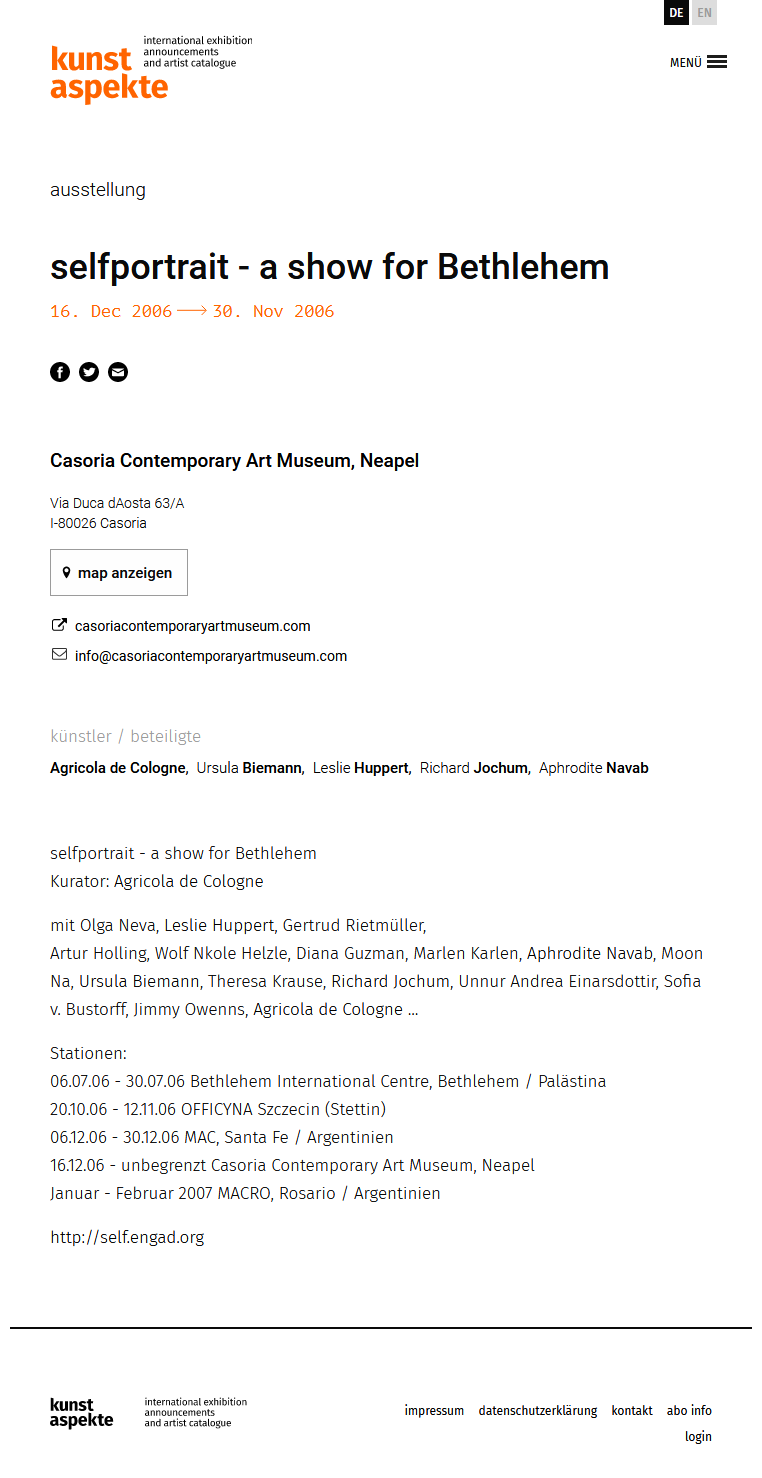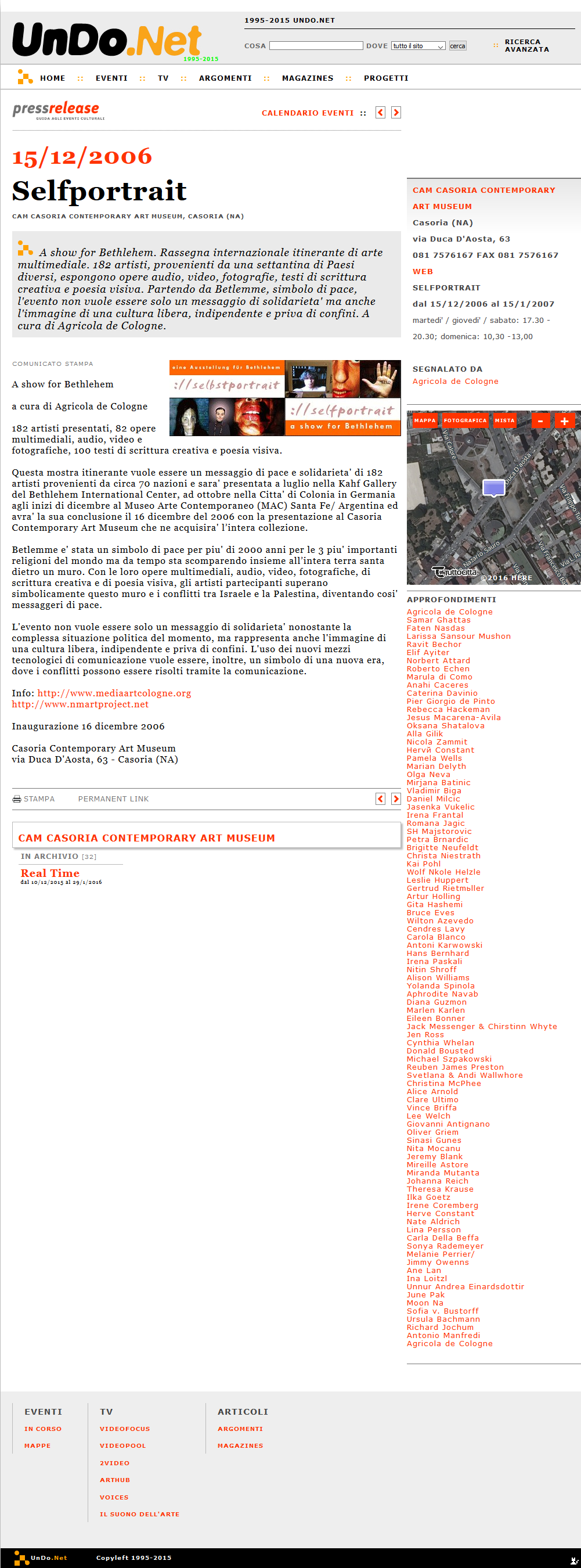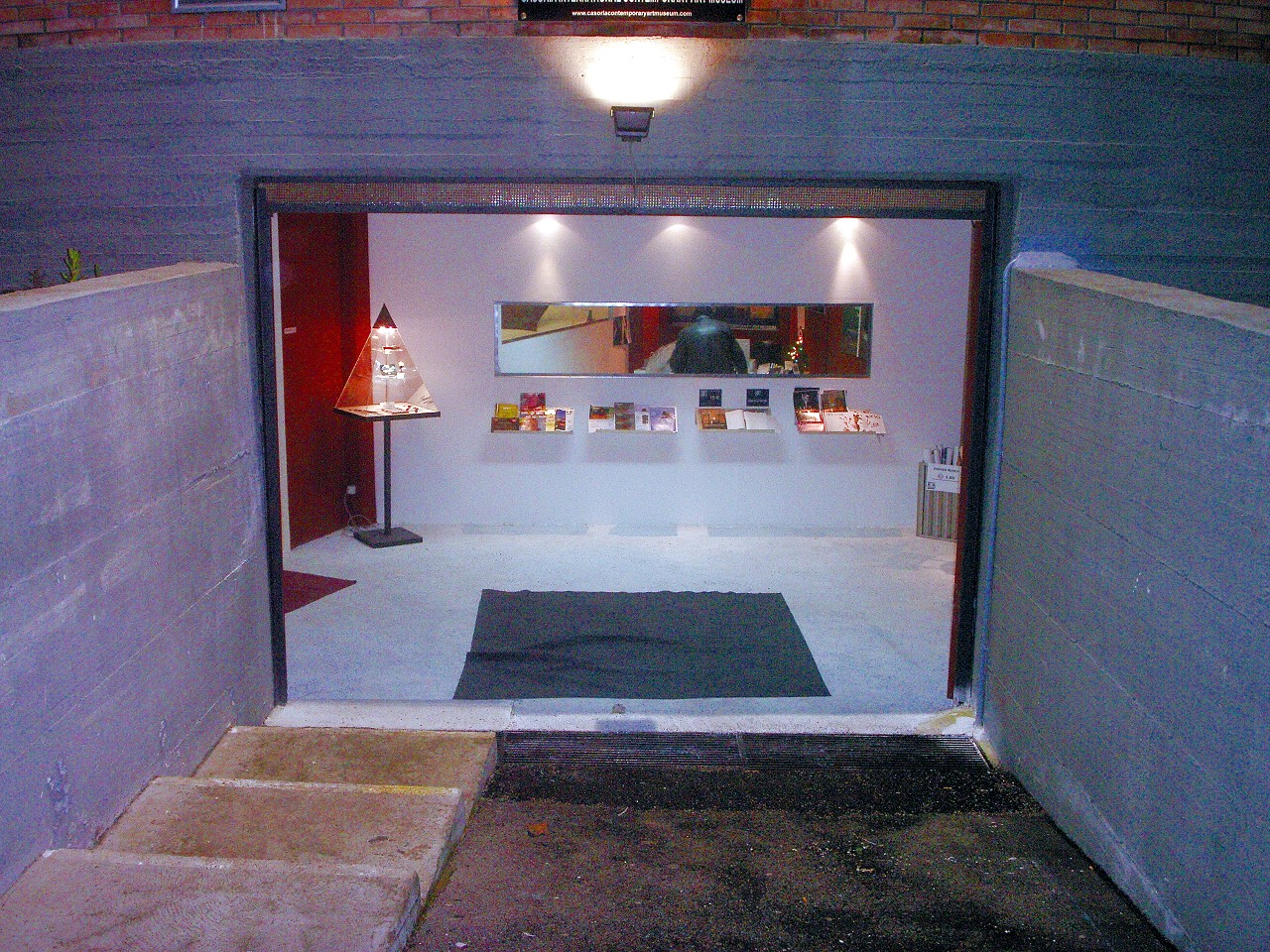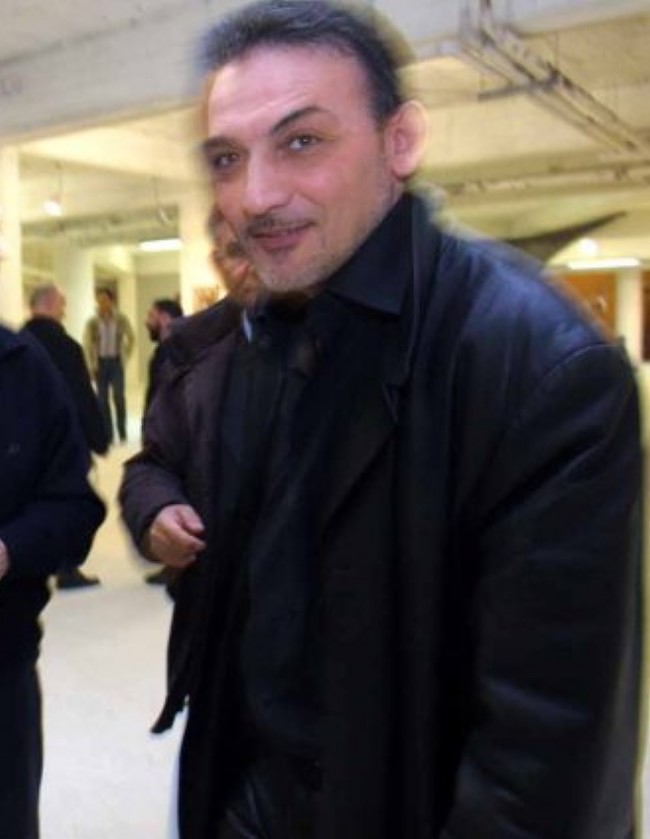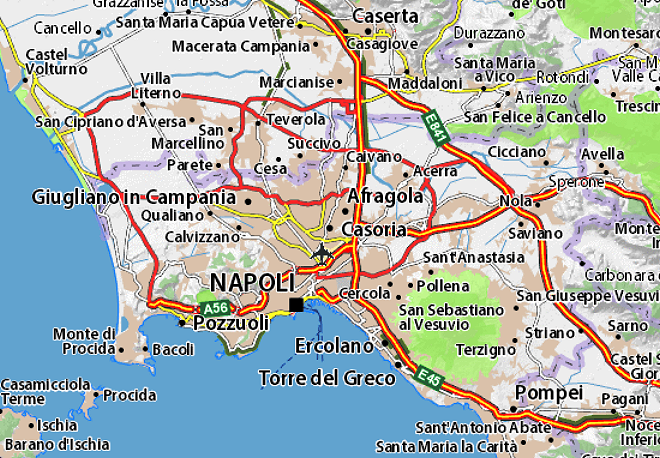Directly from Italy, the first pictures from the show at Casoria Contemporary Art Museum Naples are now online, a detailled report follows in sequence—>
—>
more articles, press released etc can be found on
https://self2006.nmartproject.net/?page_id=29
Review
://selfportrait exhibition at Casoria Contemporary Art Museum Naples/Italy
16 December 2006 – 16 January 2007
Following images document the museum space and the show–>
the text follows afterwards—>

the location–>
Casoria Contemporary Art Museum

view from outside

view from outside

entrance area

entrance area

museum – space of permanent collections

museum – space of permanent collections

museum – space of permanent collections

museum – space of permanent collections

museum – space of permanent collections

museum – space of permanent collections

museum – space of permanent collections

museum – space of permanent collections

museum – space of permanent collections – installation
.
—>
The show – the exhibition space
—>

poster outside

poster outside

director Antonio Manfredi at work

space in preparation

view on empty exhibition space

computer space – opening

computer space – opening

video projection space

space for the digital prints

Pier Giorgio de Pinto in front of his poster

Pier Giorgio de Pinto & Agricola de Cologne

digital prints 1

digital prints 2

digital prints 3

digital prints 4

digital prints 5

digital prints 6
—>
Text: review by Wilfried Agricola de Cologne
Those people who are thinking Naples would be just a nice place based on an exciting long history, has to learn the city has also an ugly industrial side and Casoria represents such an ugly suburb, which is out of function as industrial site, and in this way it represents also a place of social conflicts. In fact, the only nice thing is the view on volcano Vesuv from distance, if it is visble. December is also not really a nice time for travelling in Italy, but visiting Casoria when the weather is just cold and grey, belongs rather to the most unattractive things one can imagine. Normally a visitor finds his way to Casoria only if there is a necessity to do so, but there is no infrastructure and no tourist would ever get the idea to turn from the vivid and magnificent city center of Naples to this former industrial suburb where the garbage is lying meters high along the streets.
From this point of view it is certainly honorable, that Antonio Manfredi, himself a visual artist and director of this museum, initiated at Casoria a place and space for contemporary art, the museum of contemporary art, where ://selfportrait – a show for Bethlehem – a show for Peace was supposed to be exhibited.
If Szczecin in Poland can be seen as a symbol for Peace due to its World War II history, one can call Casoria another type of symbol due to its industrial history and its social focus nowadays.
While looking for the museum on location, the visitor however is surprised to find this museum not located at a former industrial site, but at the underground down of the building which looks much more like a museum than a secondary school, whereby the entrance has to be explored first before it can be found at the backside of the secondary school.
The museum is very young of age, actually once a private initiative is currently obviously acting under the umbrella of the Cultural Department of the municpality of Casoria.
The visitor who wants to enter has to climb the stairs down to the underground first, before then a huge and most impressive space opens which is hosting the permanent museum collection.
The paintings, drawings and installations exhibited there are from their kind and quality not different than in any other museum of contempotrary art, but the artworks were not made by famous artists as they can be found in any other art museum around the globe, but artists from the Naples region and international artists, basically friends of the director. All these smaller and bigger works are nothing else than donations, and this is really impressive again, that the entire huge collection is consisting exclusively of donations, and this seems to be also a main conceptual aspect.
There is also a section for temporary exhibitions, and this represented also the space were the selfportrait exhibition was supposed to be installed. But this space offered for the exhibition did not fit to my idea for a media art exhibition, and a new much bigger space had to be found.
Installing the show was a challenge in so far, as the phyiscal components, i.e. the digital prints were planned to be prepared on location in Naples, as they were supposed to be donated to the museum. This was really not such a fortunate agreement.
Producing prints of museum quality was under the given local conditions anything else than easy, and when they were finalized one day before the exhibition should take place, the director expressed special ideas for the installation, as he wanted each print to be extended through a kind of metal frame on the back for a special hanging with a certain distance from the wall.
All this took so much time during all the night, that only on the very day when the opening was supposed to take place on 16 December, all the more than 50 prints could be hanged on the walls. Also the computers were ready also only a few hours before the opening and from the two projectors which were supposed to run the two programs of videos, one was defect, and the video monitors were not available, at all.
Who had expected an opening ceremory which would be appropriate to the status and aims of the exhibition, where the director was speaking and the curator of the show would have spoken an introduction how to deal with media art in general and in partcular in the case of this exhibition, who had expected a ceremony where the exhibition was given as a donation to the museum as an offical act, this person, in first place it was me, was extraordinary disappointed, because Antonio Manfredi had not planned such a ceremony and I was not informed about this course of events.
Even if the installation was the best what was possible under the given circumstances, in fact the final result was acceptable and I liked it (see also the images), however, the way how the museum and its director were dealing with this exhibition and its donation to the museum, does not belong to what I would have wanted for the show, the artists and finally also the audience.
Especially the fact that the exhibition is based on communicating technology, the lack of communicating stood in contrary to what could be expected.
This was really a strange opening of an exhibition at a strange place somewhere on an alien planet.
The images (see further ahead) give more an objective view on the exhibition than I am able to express myself in words.
From the beginning of the plannings, I warned the participating artists in the exhibition, that the realisation of this show in general, but also at Casoria would belong rather to the category “experiment”, it really did, but retrospectively seen, I am not sure whether this experiment was successful.
While I am not happy as the curator and creator the show, the participating artists have certainly no reason to complain, as from an aesthetic point of view the show was finally well installed, and that’s also what the visitors could perceive. Further I was informed that the incomplete video equipment was immediately after the opening properly and completely installed, and this represents the most important finally.
I received some good feedback from the show, and I also think it represents certainly a good thing to bring new ideas of contemporary art to such a cultural desert as Casoria represents.
Wilfried Agricola de Cologne
January 2007
video feature
Casoria Contemporary Art Museum
selpf-portrait
A Show for Bethlehem – a show for Peace
Casoria
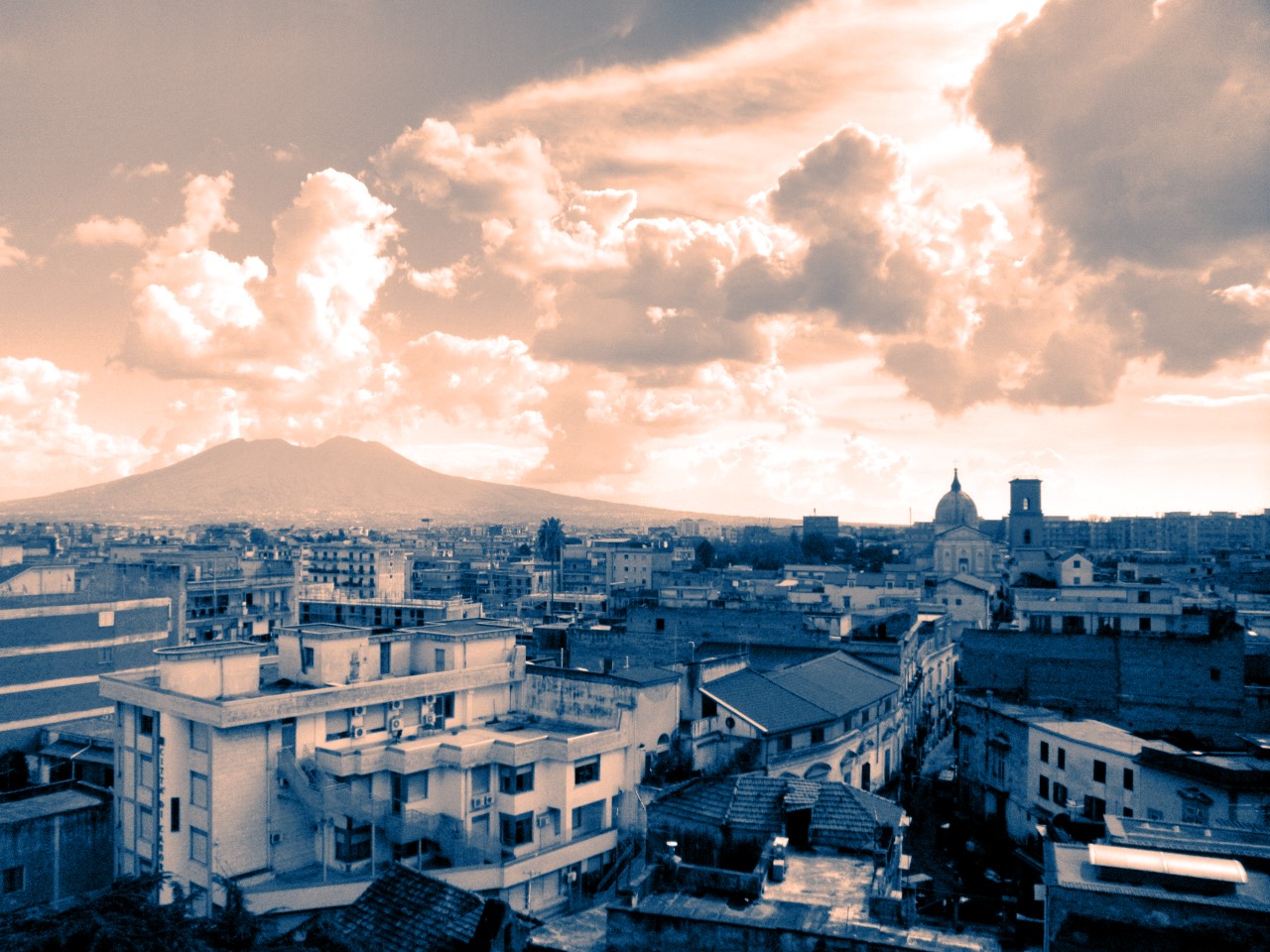

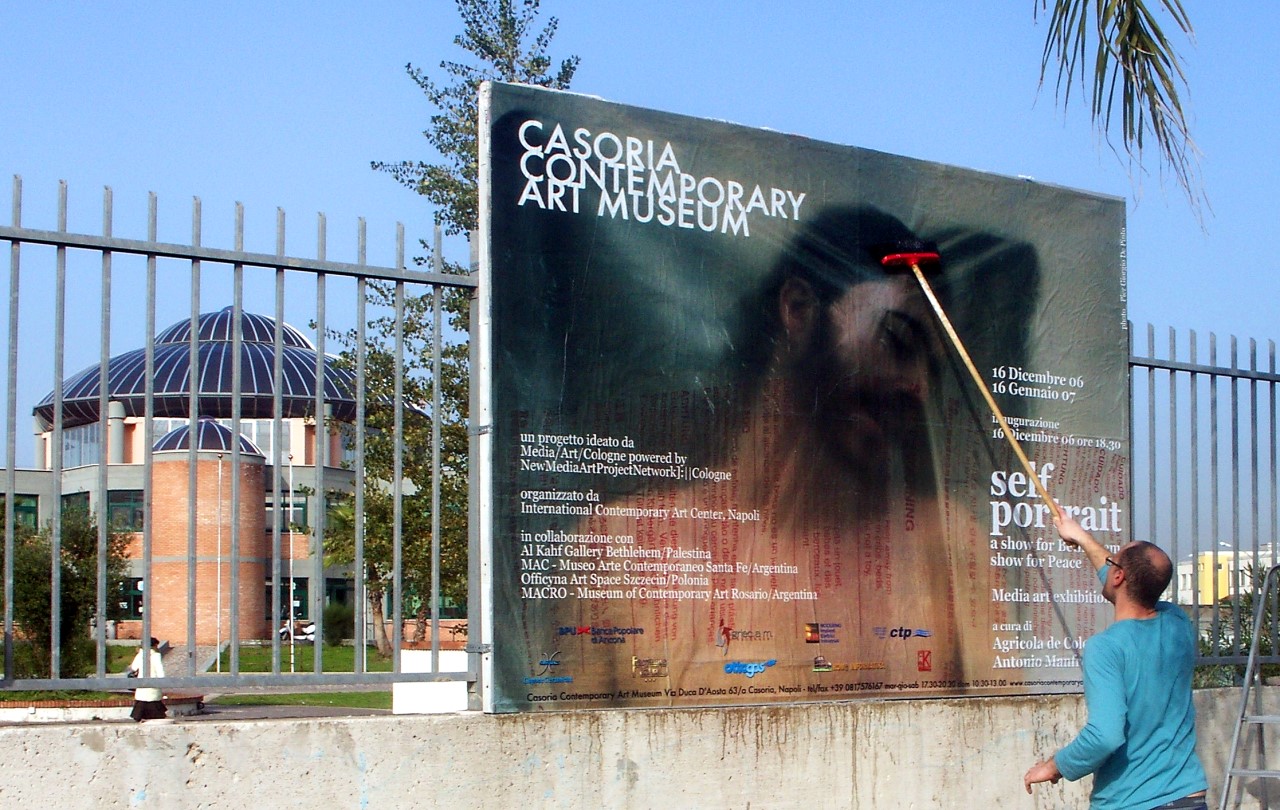
Text: review by Wilfried Agricola de Cologne
Those people who are thinking Naples would be just a nice place based on an exciting long history, has to learn the city has also an ugly industrial side and Casoria represents such an ugly suburb, which is out of function as industrial site, and in this way it represents also a place of social conflicts. In fact, the only nice thing is the view on volcano Vesuv from distance, if it is visble. December is also not really a nice time for travelling in Italy, but visiting Casoria when the weather is just cold and grey, belongs rather to the most unattractive things one can imagine. Normally a visitor finds his way to Casoria only if there is a necessity to do so, but there is no infrastructure and no tourist would ever get the idea to turn from the vivid and magnificent city center of Naples to this former industrial suburb where the garbage is lying meters high along the streets.
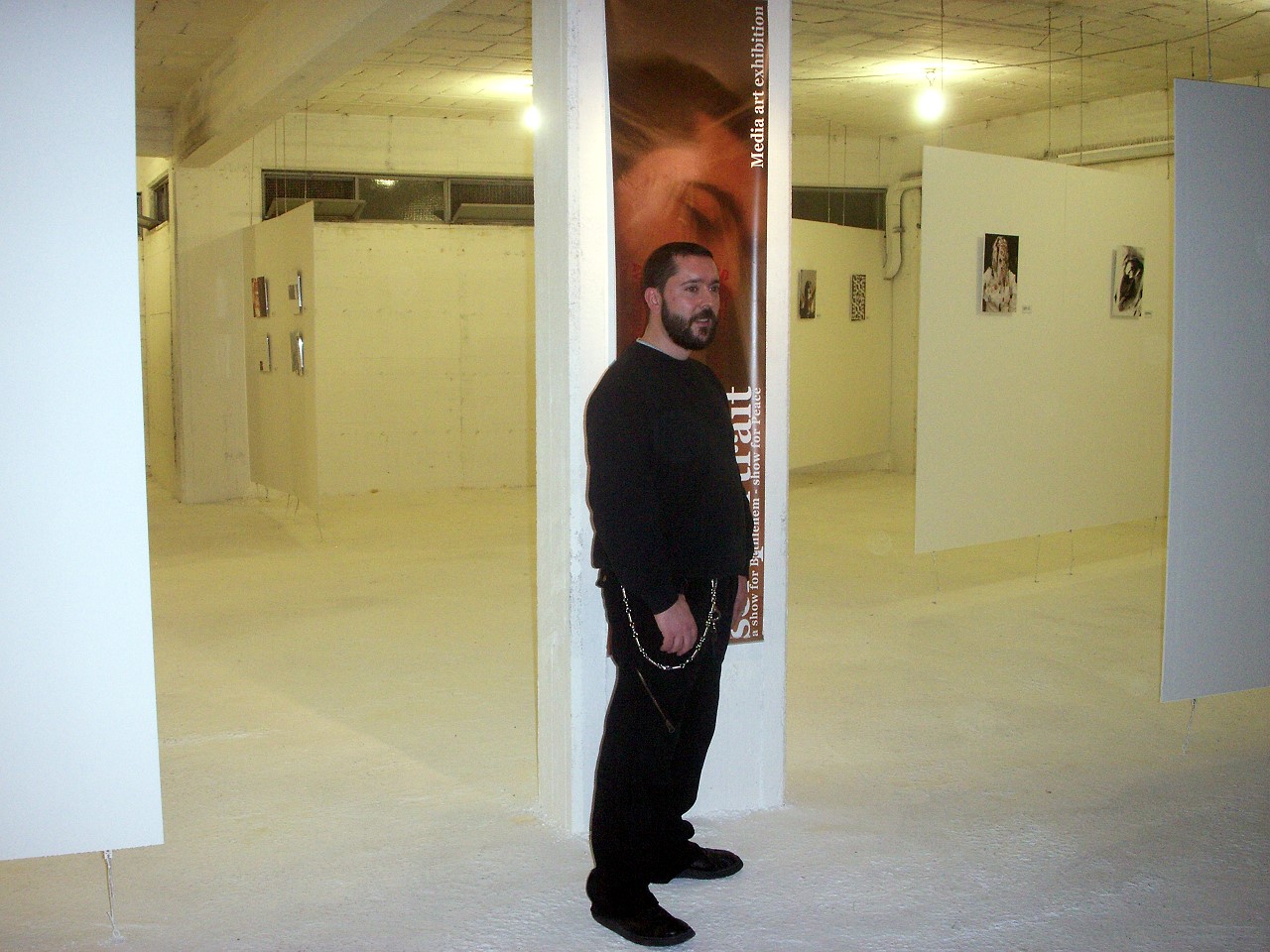
If Szczecin in Poland can be seen as a symbol for Peace due to its World War II history, one can call Casoria another type of symbol due to its industrial history and its social focus nowadays.
While looking for the museum on location, the visitor however is surprised to find this museum not located at a former industrial site, but at the underground down of the building which looks much more like a museum than a secondary school, whereby the entrance has to be explored first before it can be found at the backside of the secondary school.
The museum is very young of age, actually once a private initiative is currently obviously acting under the umbrella of the Cultural Department of the municpality of Casoria.
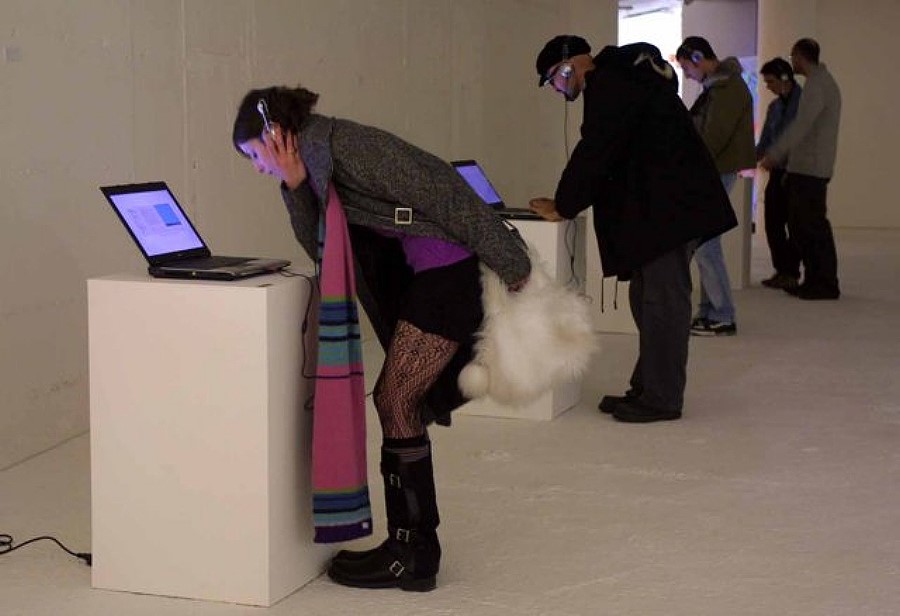
The visitor who wants to enter has to climb the stairs down to the underground first, before then a huge and most impressive space opens which is hosting the permanent museum collection.
The paintings, drawings and installations exhibited there are from their kind and quality not different than in any other museum of contempotrary art, but the artworks were not made by famous artists as they can be found in any other art museum around the globe, but artists from the Naples region and international artists, basically friends of the director. All these smaller and bigger works are nothing else than donations, and this is really impressive again, that the entire huge collection is consisting exclusively of donations, and this seems to be also a main conceptual aspect.
There is also a section for temporary exhibitions, and this represented also the space were the selfportrait exhibition was supposed to be installed. But this space offered for the exhibition did not fit to my idea for a media art exhibition, and a new much bigger space had to be found.
Installing the show was a challenge in so far, as the phyiscal components, i.e. the digital prints were planned to be prepared on location in Naples, as they were supposed to be donated to the museum. This was really not such a fortunate agreement.
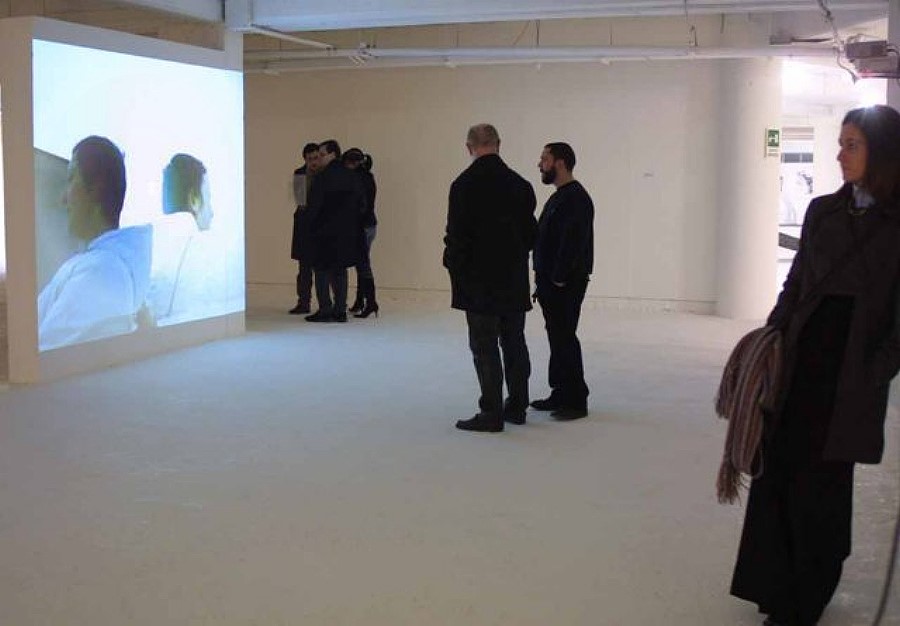
Producing prints of museum quality was under the given local conditions anything else than easy, and when they were finalized one day before the exhibition should take place, the director expressed special ideas for the installation, as he wanted each print to be extended through a kind of metal frame on the back for a special hanging with a certain distance from the wall.
All this took so much time during all the night, that only on the very day when the opening was supposed to take place on 16 December, all the more than 50 prints could be hanged on the walls. Also the computers were ready also only a few hours before the opening and from the two projectors which were supposed to run the two programs of videos, one was defect, and the video monitors were not available, at all.
Who had expected an opening ceremory which would be appropriate to the status and aims of the exhibition, where the director was speaking and the curator of the show would have spoken an introduction how to deal with media art in general and in partcular in the case of this exhibition, who had expected a ceremony where the exhibition was given as a donation to the museum as an offical act, this person, in first place it was me, was extraordinary disappointed, because Antonio Manfredi had not planned such a ceremony and I was not informed about this course of events.
Even if the installation was the best what was possible under the given circumstances, in fact the final result was acceptable and I liked it (see also the images), however, the way how the museum and its director were dealing with this exhibition and its donation to the museum, does not belong to what I would have wanted for the show, the artists and finally also the audience.
Especially the fact that the exhibition is based on communicating technology, the lack of communicating stood in contrary to what could be expected.
This was really a strange opening of an exhibition at a strange place somewhere on an alien planet.
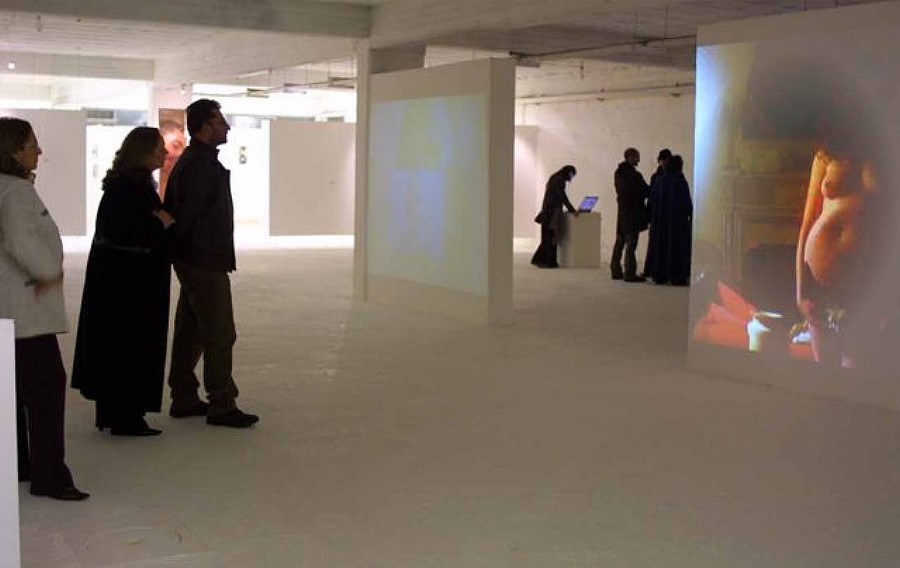
The images (see further ahead) give more an objective view on the exhibition than I am able to express myself in words.
From the beginning of the plannings, I warned the participating artists in the exhibition, that the realisation of this show in general, but also at Casoria would belong rather to the category “experiment”, it really did, but retrospectively seen, I am not sure whether this experiment was successful.
While I am not happy as the curator and creator the show, the participating artists have certainly no reason to complain, as from an aesthetic point of view the show was finally well installed, and that’s also what the visitors could perceive. Further I was informed that the incomplete video equipment was immediately after the opening properly and completely installed, and this represents the most important finally.
I received some good feedback from the show, and I also think it represents certainly a good thing to bring new ideas of contemporary art to such a cultural desert as Casoria represents.
Wilfried Agricola de Cologne
January 2007
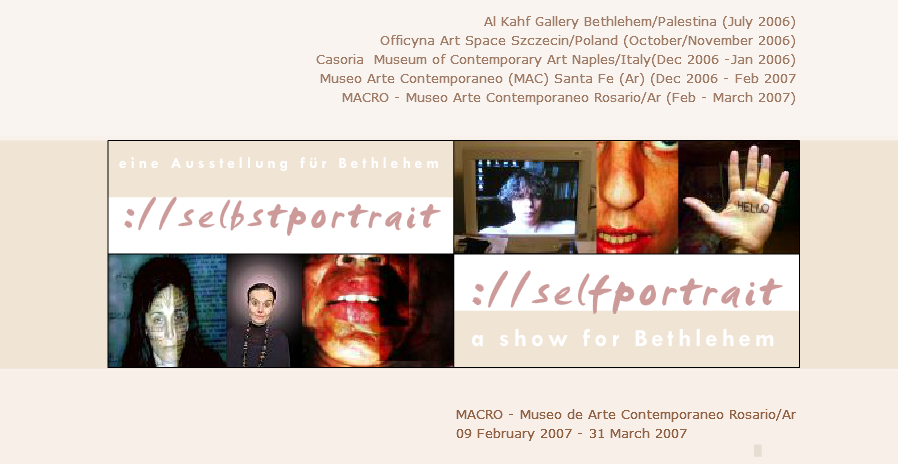

On 16 December 2006,
Casoria Contemporary Art Museum Naples/Italy
is inaugurating the media art exhibition
://selfportrait – a show for Bethlehem – a show for Peace.
The show is running until 16 January 2007.
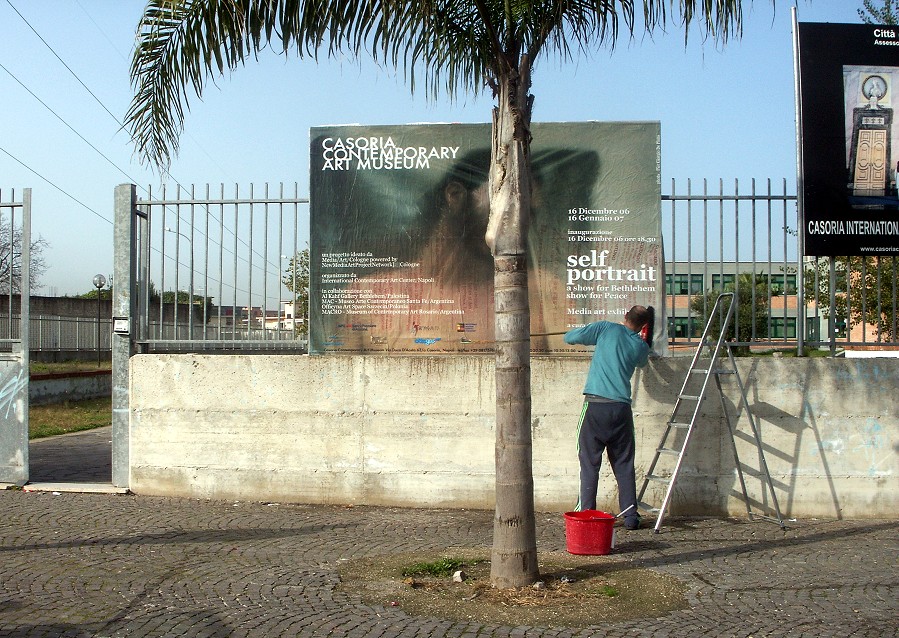
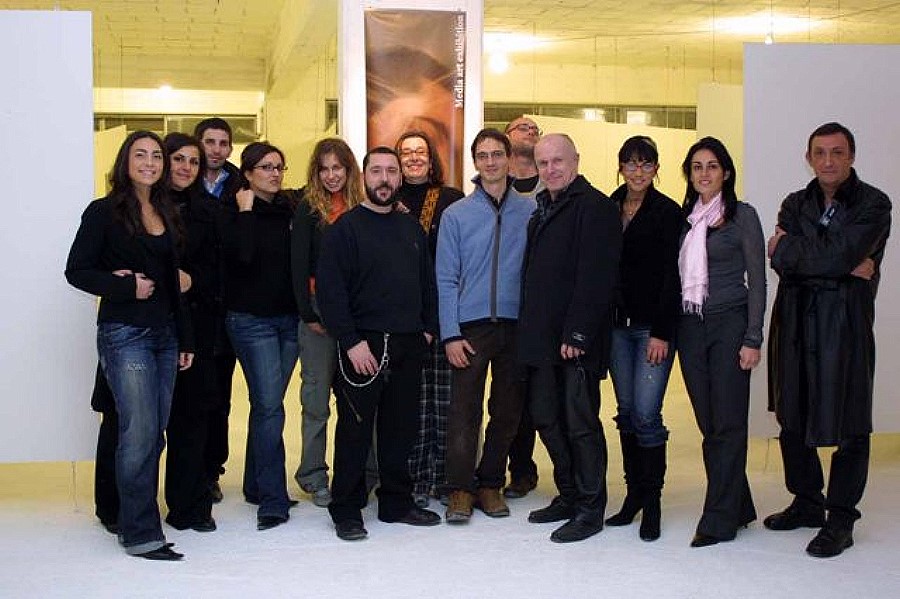
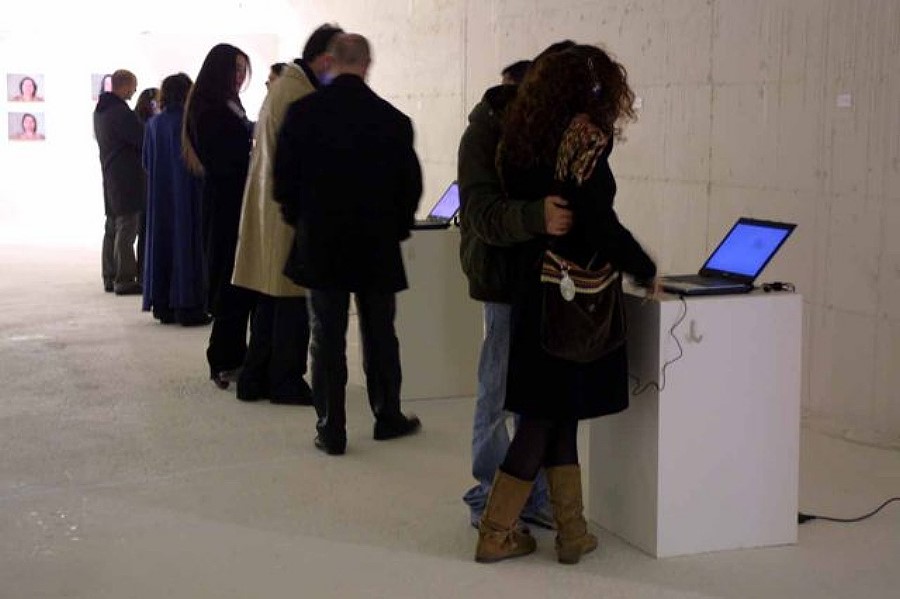
Directly from Italy, the first pictures from the show at Casoria Contemporary Art Museum Naples are now online, a detailled report follows in sequence--->
http://downloads.nmartproject.net/museo_casoria_press_in_italiano.pdf
Review
://selfportrait exhibition at Casoria Contemporary Art Museum Naples/Italy
16 December 2006 - 16 January 2007
Following images document the museum space and the show-->
the text follows afterwards--->
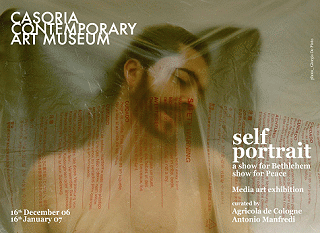
the location-->
Casoria Contemporary Art Museum
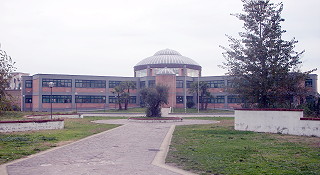
view from outside
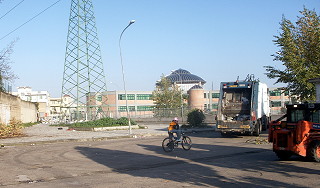
view from outside
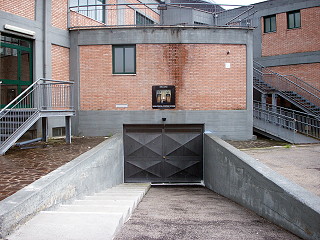
entrance area
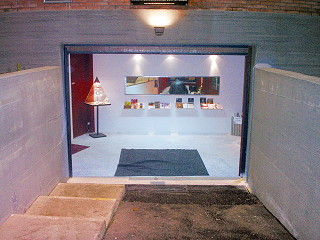
entrance area
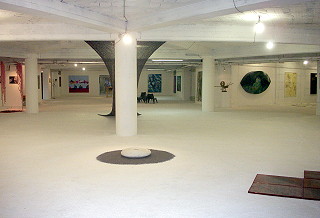
museum - space of permanent collections
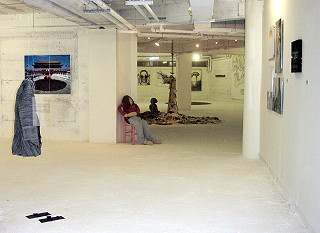
museum - space of permanent collections
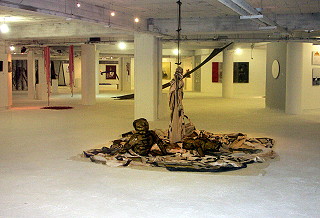
museum - space of permanent collections
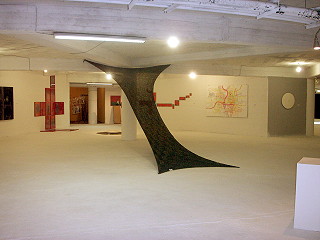
museum - space of permanent collections
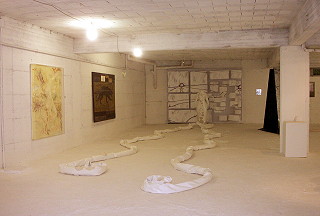
museum - space of permanent collections
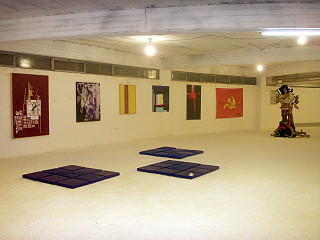
museum - space of permanent collections
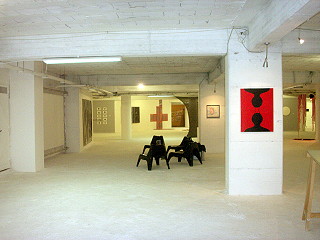
museum - space of permanent collections
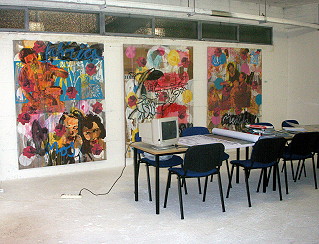
museum - space of permanent collections
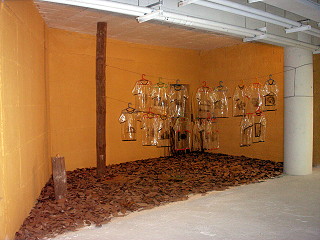
museum - space of permanent collections - installation
.
--->
The show - the exhibition space
--->
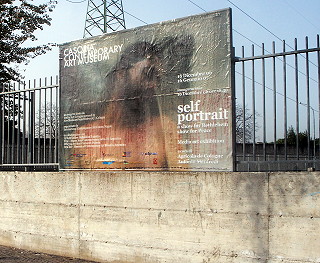
poster outside
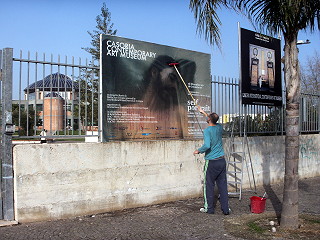
poster outside
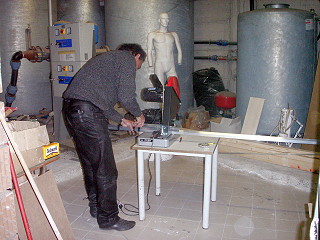
director Antonio Manfredi at work

space in preparation
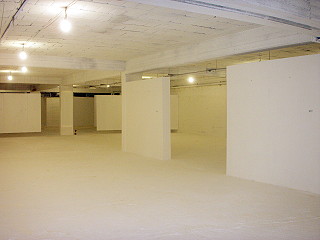
view on empty exhibition space
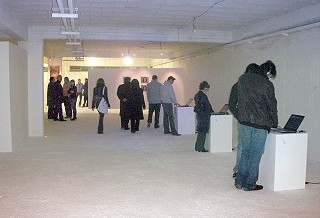
computer space - opening
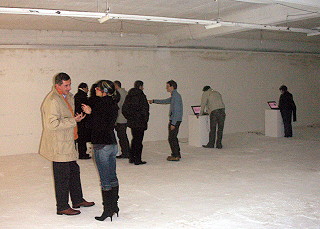
computer space - opening
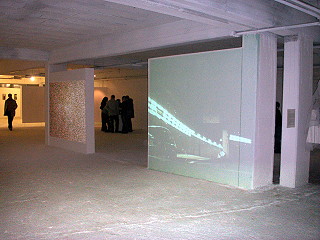
video projection space
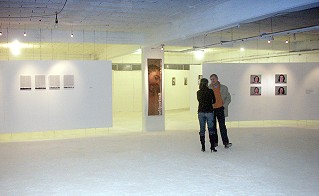
space for the digital prints
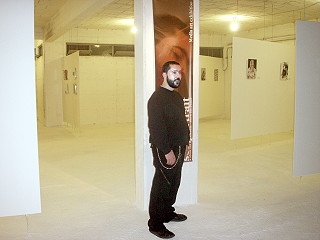
Pier Giorgio de Pinto in front of his poster
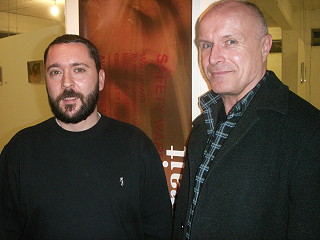
Pier Giorgio de Pinto & Agricola de Cologne
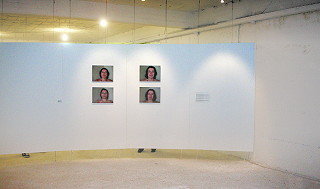
digital prints 1
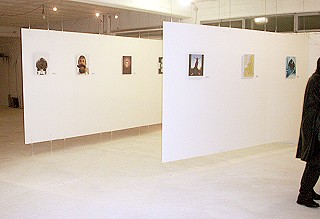
digital prints 2
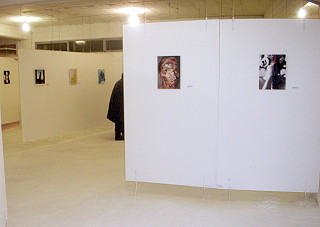
digital prints 3
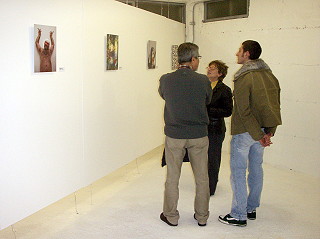
digital prints 4
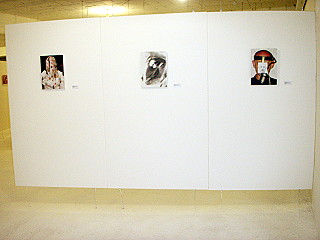
digital prints 5
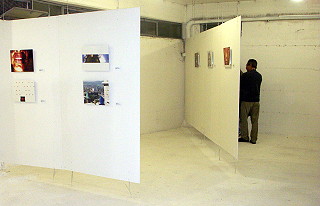
digital prints 6
